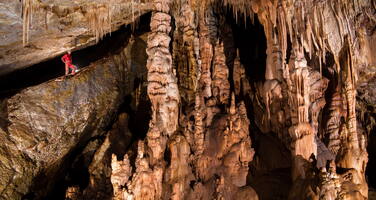Caves of Aggtelek Karst and Slovak Karst
Factors affecting the property in 2000*
- Erosion and siltation/ deposition
- Quarrying
International Assistance: requests for the property until 2000
Total amount approved : 0 USD
Missions to the property until 2000**
Information presented to the Bureau of the World Heritage Committee in 2000
New information: IUCN, based on information provided in “Karst Conduit”, the newsletter of the International Geographical Union Commission on Man and Karst, has reported to the Centre that while the main caves have been inscribed on the World Heritage List, the land above them, including the allogenic catchments of the caves, are not protected. Agricultural activity in the catchments has resulted in soil erosion and the sediment is being delivered into the caves. There have been reports of impacts on the karst environment from communal sewage and from the quarry previously in operation at Estramos Hill. This is an issue of concern for IUCN, as the impact of activities in upstream catchment areas can significantly impact on the quality of the karst environment of the World Heritage site. IUCN suggests that the State Party facilitate co-operative management planning with the owners of the land above the caves and in associated catchment areas, to minimise impacts on the World Heritage values of the caves.
The Secretariat will transmit IUCN’s observations and concerns to the State Party and request the State Party to initiate a management planning process, in co-operation with the owners of the land above the caves and in associated catchment areas, in order to minimise impacts on the caves. The State Party will be requested to provide a response to the issues raised, and the proposals of IUCN before 15 September 2000 in order to enable the Centre to report to the twenty-fourth extraordinary session of the Bureau in November 2000.
Action Required
Note: this report was presented to the Bureau for noting only.
Summary of the interventions
Decisions adopted by the Committee in 2000
24 BUR IV.B.78
State of conservation
The Bureau took note of the information provided in the working document on the state of conservation of the following properties:
NATURAL HERITAGE
Comoe National Park (Côte d’Ivoire)
Caves of the Aggtelek and Slovak Karst (Hungary/Slovakia)
The Delegate of Morocco pointed out that the protection of surface water is important in karst systems.
Kaziranga National Park (India)
Lorentz National Park (Indonesia)
Kamchatka Volcanoes (Russian Federation)
Sinharaja Forest Reserve (Sri Lanka)
Bwindi Impenetrable Forest (Uganda)
CULTURAL HERITAGE
Rock-hewn Churches, Lalibela (Ethiopia)
Vilnius Historic Centre (Lithuania)
City of Cuzco (Peru)
Chavin (Archaeological Site) (Peru)
Lines and Geoglyphs of Nasca and Pampas de Jumana (Peru)
24 COM X.A.3
Extension - Caves of the Aggtelek Karst and Slovak Karst (Hungary/Slovakia)
Property: Caves of the Aggtelek Karst and Slovak Karst
Id. N°: 725-858 bis
State Party: Hungary / Slovakia
Criteria
The Committee approved the incorporation of the Dobšinská Ice Cave as part of the Caves of the Aggtelek Karst and Slovak Karst World Heritage site. Although this ice cave is a relatively small (6km2) and specialised feature, it does add variety to the existing site and its features relate to and complement the Caves of Aggtelek Karst and Slovak Karst.
The Delegate of Hungary welcomed the extension and the Observer of Slovakia informed the Committee that an intergovernmental agreement between the two States Parties was established in 1999 for joint projects including research, protection and monitoring.
Exports
* :
The threats indicated are listed in alphabetical order; their order does not constitute a classification according to the importance of their impact on the property.
Furthermore, they are presented irrespective of the type of threat faced by the property, i.e. with specific and proven imminent danger (“ascertained danger”) or with threats which could have deleterious effects on the property’s Outstanding Universal Value (“potential danger”).
** : All mission reports are not always available electronically.


